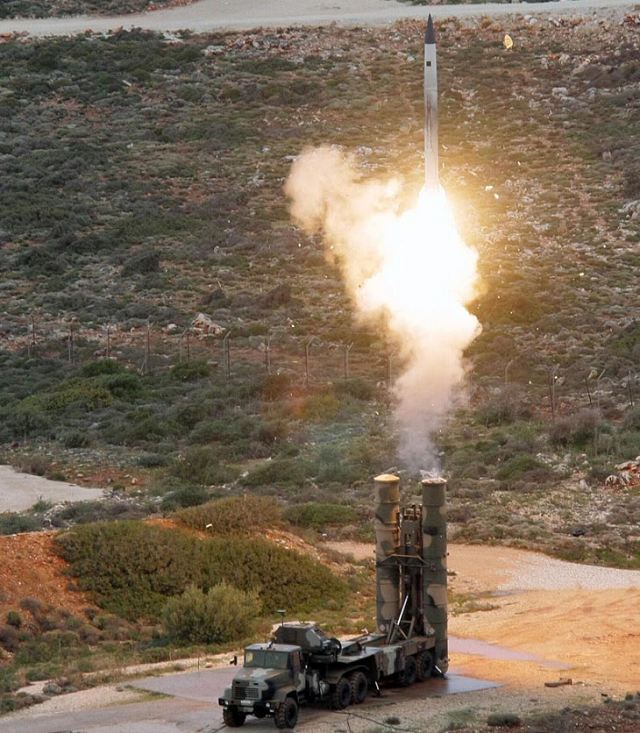
Newsroom
The theory that Greece’s Cypriot-bought Russian-made S-300 could be heading for Ukraine got some attention this week, after Ankara insisted that Athens used the previously-forgotten missile system to lock on a Turkish plane over the weekend, a claim Greek officials deny.
Turkish President Recep Tayyip Erdogan on Tuesday revisited Ankara’s claim that Greek S-300 surface-to-air missiles stored on the island of Crete had locked on a Turkish aircraft west of Rhodes on Sunday, accusing Greece of a “hostile act.”
"Greece has challenged NATO and its allies by increasing its hostile attitude, which started with harassing our airspace and aircraft and escalated to the level of S-300 radar lockdown," Erdogan told a friendly crowd in Ankara during Turkey’s Victory Day.
A quarter century ago NATO warned that S-300 in Crete could threaten both Greek and Turkish warplanes alike due to lack of IFF, with Forbes saying it was unclear if Athens has resolved the issue
Athens has denied its S-300 had been used against the Turkish aircraft, saying it was four Greek F-16 jets that tracked the plane instead.
The S-300 made headline news recently after Washington called on the Republic of Cyprus, Greece, and other allies to transfer their Russian-made military systems to Ukraine to boost Kiev’s resistance to Moscow’s attacks.
Foreign media were quick to speculate that if a Greek S-300 radar did indeed lock-on to Turkish F-16s this August, this could be an indication that Athens was either testing the system again or considering putting them into active military service.
A quarter century ago, after Greece obtained the S-300 from Cyprus, NATO diplomats warned that the S-300 system installed in Crete could threaten both Greek and Turkish warplanes alike, “given that they lacked NATO standard Identification Friend or Foe systems.”

According to Forbes, it remained unclear if Greece had managed to resolve the IFF issue, with media speculating whether Ankara’s allegations could be accurate.
“Either way, putting these strategic Russian missile systems into active service now could risk a significant escalation in recurring Greek-Turkish tensions over the Aegean with unpredictable consequences,” a Forbes contributor wrote on Sunday.
Cyprus in the mix
Cyprus originally bought the S-300’s but ordered them delivered on Crete back in the mid-1990’s, after Turkey objected to the divided island obtaining such a capable defense system that could also threaten the mainland.
The Cypriot Defense Ministry never ruled out shipments to Ukraine but said it would only exchange parts with a third country before allowing for the transfer.
Last week it emerged that Nicosia had signed up for new technology from Iron Dome, an exclusive joint US-Israeli defense system, with media speculating the island could be replacing its Russian-made Tor-M1 and Buk-M1 air defense systems that could be heading for Ukraine.
The Cypriot Defense Ministry never ruled out shipments to Ukraine but said it would only exchange parts with a third country before allowing for the transfer.
Earlier this summer Greek Defense Minister Nikos Panagiotopoulos publicly ruled out the prospect of Athens transferring S-300 to Ukraine, citing “a real threat” from Turkey.
“We are not going to weaken our country,” Panagiotopoulos reassured a House committee back in May.
In later statements Panagiotopoulos clarified that Greece would not be sending to Ukraine “what we need, what is useful, and mainly operationally active.”
Ukraine urgently needs S-300
Slovakia was the first NATO country to provide S-300 to Ukraine back in April, but aerial photos in the media days later showed those defense systems had been destroyed by Russian attacks before they could become operational.
While it remained unclear whether Greece could be sending S-300 to Ukraine, Reuters reported over the weekend that Russia has already shipped a battery of S-300 from Syria to a Russian port near Crimea, citing an Israeli satellite imaging company.
The Soviet-era long-range surface-to-air missile system can shoot down cruise missiles and aircraft and has a range of up to 90 miles.































